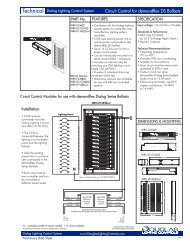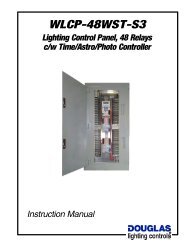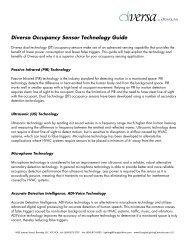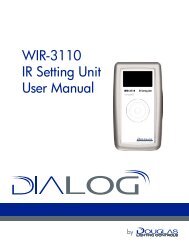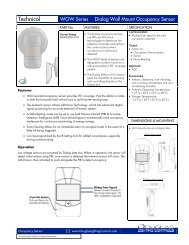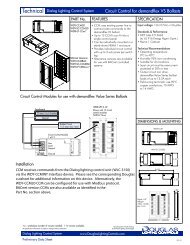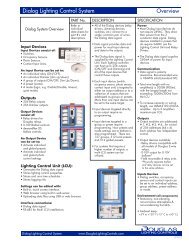noncondensing
WOSSDG1-P-VW Technical Data - Douglas Lighting Control
WOSSDG1-P-VW Technical Data - Douglas Lighting Control
- No tags were found...
You also want an ePaper? Increase the reach of your titles
YUMPU automatically turns print PDFs into web optimized ePapers that Google loves.
Technical WOS Series Dialog Wall Switch Occupancy Sensor<br />
Features<br />
PART No. FEATURES SPECIFICATION<br />
Standard Range<br />
WOSSDG1-P-VW<br />
• The Dialog occupancy sensors use<br />
PIR and ADI-Voice technologies to<br />
determine the presence of people<br />
and perform the control actions<br />
when occupancy (or vacancy) is<br />
detected<br />
• The WOS Series of sensors are<br />
designed replace a low voltage wall<br />
switch giving a 180° coverage<br />
pattern<br />
• The Dialog edition of this sensor<br />
gives the capability of operating and<br />
controlling directly on the Dialog<br />
bus<br />
• Wall Switch occupancy sensor provides 180° coverage to maximize the sensor<br />
area.<br />
• The dual-tech sensor utilizes ADI-Voice Technology, which has advanced digital<br />
signal processing for accurate detection of human speech.<br />
• A Self-Adapting mode can be set to use both Passive Infrared (PIR) & Accurate<br />
Detection Intelligence (ADI) Voice technologies to automatically track occupancy<br />
tendencies for continuous maximizing of energy savings.<br />
• Smart Sensing allows for an immediate return to occupied mode in the event of a<br />
false off being triggered.<br />
• Can be programmed by the IR Setting Unit for added convenience, especially during<br />
commissioning.<br />
Communication<br />
• Dialog Data signal is the only<br />
connection required<br />
Output<br />
• Action on:<br />
• Occupancy/Unoccupancy<br />
• Switch<br />
• Photo Reading<br />
Approvals<br />
• FCC<br />
Environment<br />
• Indoors, stationary, non-vibrating,<br />
non-corrosive atmosphere and <strong>noncondensing</strong><br />
humidity<br />
• Ambient Operating Temperature:<br />
14°F to 140°F (-10°C to 60°C)<br />
• Storage Temperature:<br />
-14°F to 140°F (-25°C to 60°C)<br />
Operation<br />
Low voltage sensors are powered by Dialog Bus. When in operation, the sensor will detect<br />
initial motion using PIR; once motion is detected the internal contact will close. The ADI-Voice<br />
is then activated to work alongside the PIR to detect occupancy.<br />
DIMENSIONS & MOUNTING<br />
• Mount in a standard gang box.<br />
Occupancy Sensor<br />
www.DouglasLightingControls.com<br />
R1.4<br />
Preliminary data subject to change without notice
Coverage WOS Series Dialog Wall Switch Occupancy Sensor<br />
INSTALLATION<br />
• Mount the WOS Series sensor on the wall about 4' above floor level near the midline of the room so its PIR detection zones cover<br />
the room area and any obstructions are within range of the ADI-Voice detector.<br />
• There should be no obstructions between the sensor and the room entrance. This ensures that the sensor's PIR lens will be activated<br />
when a person enters the room, which will subsequently trigger the ADI-Voice.<br />
Installing in Offices<br />
• Sensor effective in obstructed spaces.<br />
• ADI-Voice re-activation and Smart Sense prevents lights out condition.<br />
Standard Lens<br />
• Optimal usage is to detect small motions such as hand movements<br />
• Designed for a mounting height of up to 4ft<br />
• ADI-Voice can detect around corners that PIR cannot to maintain<br />
occupancy.<br />
Top View<br />
15 ft<br />
7.5 ft<br />
0 ft<br />
Typical Office<br />
7.5 ft<br />
Installing in Washrooms<br />
• Sensor effective in partitioned spaces.<br />
• ADI-Voice re-activation and Smart Sense prevents lights out condition.<br />
15 ft<br />
Side View<br />
4 ft<br />
0 ft<br />
0’ 15’<br />
Typical Washroom<br />
Occupancy Sensor<br />
www.DouglasLightingControls.com<br />
R1.4<br />
Preliminary data subject to change without notice
Features WOS Series Dialog Ceiling Occupancy Sensor<br />
Wiring Instructions<br />
The WOS Series Low Voltage sensors are equipped with #18 AWG leads. Use appropriate sized wire-nuts to connect the wires to<br />
the incoming load terminations.<br />
Sensor Settings<br />
Programming - IR / Manual Setting<br />
Programming can be done with the WIR-3110 setting unit. For more details and additional options please see the “IR Setting Unit Manual”<br />
Detection (Dual or PIR Only)<br />
When in operation, the sensor will detect initial motion using Passive Infrared; once motion is detected the ADI-Voice is then is activated to work<br />
alongside the PIR to maintain occupancy. The ADI-Voice can be disabled on any dual tech sensors.<br />
Automatic Timeout<br />
By setting the timeout dial to maximum, the sensor will be put into automatic mode which will adjust the time out automatically to maximize energy<br />
savings and occupant comfort.<br />
Smart Sensing<br />
When vacancy occurs, sensitivity of the ADI-Voice technology transitions from maximum to zero over an adaptively determined time period, based on<br />
occupancy tendencies. During this period, ADI-Voice can turn the lights back on immediately, even with no line-of-sight to the sensor, assuring the best<br />
combination of user convenience and energy savings.<br />
Energy consumption due to false triggers is minimized by the automatic walk-through mode. This feature turns the lights off after 3 minutes if no<br />
occupancy detection occurs in the first 30 seconds after initial turn on.<br />
Vacancy Mode<br />
The low voltage sensor can be selected as a vacancy (Off only) sensor. This provides additional energy savings by forcing the user to turn the lights on<br />
manually. The low voltage sensor has a built-in override input; allowing for the sensor to be operated as a vacancy sensor. For two pole sensors, it<br />
provides multi-level control capability.<br />
Photo Sensing (-P)<br />
When enabled, occupancy alone will not trigger the output state to on. If occupancy is detected AND there is a deficiency of natural light, the output<br />
is triggered on. An increase in natural light will not force the lights off but as the ambient light level drops the lights will turn on automatically. This<br />
feature will also limit the manual switching, ensuring the lights are not turned on if adequate light is present.<br />
Profile<br />
The Dialog sensor exists as three profiles in the system: a Switch, a Photocell, and an Occupancy Sensor. Each profile element can<br />
control separate control targets.<br />
Summary of Configuration Options<br />
Each building is unique in its lighting needs. Diversa sensors provide the user with a wide variety of configuration<br />
options to ensure each building’s individual needs are met.<br />
• Timeout 30 sec - 30 min or self adapting<br />
• Adjustable PIR Sensitivity<br />
• Adjustable Detect Intelligence Voice (ADI-Voice) Sensitivity<br />
• Enable/Disable ADI-Voice<br />
• Enable/Disable LED Indicators<br />
• Enable/Disable Walk Through Mode<br />
• Set parameters for light level setting upon occupancy detection<br />
* Application and Performance Specification Information Subject to Change without Notification<br />
Occupancy Sensor<br />
www.DouglasLightingControls.com<br />
R1.4<br />
Preliminary data subject to change without notice






